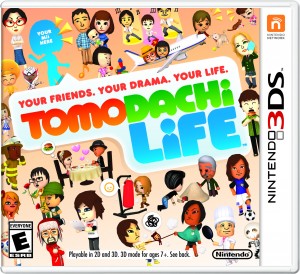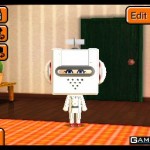 Every once in a while Nintendo will actually release something new and different just to prove to its naysayers that it can do what they claim Nintendo doesn’t do. Only it’s not that new, considering there was a Tomodachi Collection on the DS before this game, Tomodachi Life. The ‘life-sim’ that uses Mii data to creates a bunch of silly events involving your Mii, for the 3DS. But this ‘game’ isn’t exactly a game at all. Read on to see what that actually means.
Every once in a while Nintendo will actually release something new and different just to prove to its naysayers that it can do what they claim Nintendo doesn’t do. Only it’s not that new, considering there was a Tomodachi Collection on the DS before this game, Tomodachi Life. The ‘life-sim’ that uses Mii data to creates a bunch of silly events involving your Mii, for the 3DS. But this ‘game’ isn’t exactly a game at all. Read on to see what that actually means.
Tomodachi Life is kind of like a life-sim, only it’s mostly hands-off. After making or importing Miis made through the Mii Maker, the ones encountered via Streetpass, or your friend list: You can edit their settings to have them resemble the person that they represent as close as possible. After you are content with the number of Mii’s that fill up your apartment buildings, you can then Name the Island. Inappropriate names or terms are strictly prohibited though. But you can get away with a bit if you are savvy with language. From there, the game becomes a hands-off life-sim, where if you wait long enough, events will happen, like markets being opened up. To gain money to buy these items, you will be tasked with helping the Miis solve their problems, be it personal, love, or friendship. This increases their happiness meter, which can be leveled up. You also get a bit of money for your trouble. When the Mii’s happiness level goes up, you can give them a gift: Gifts range anywhere from clothing, interiors, and other gifts to gift to other Mii’s. You can also peer into sleeping Mii’s dreams. This is where most of the weird stuff happens, outside of the Mii News, where apparently every islander is an eligible newscaster.
There are some mini-games you can play, but outside of that, it’s pretty much the extent of your influence of what the Mii’s will do. Every scripted event plays out randomly. One thing to not though that’s both odd and amusing is that every Mii talks with a very robotic text-to-speech translator much like Siri, only far creepier, depending on the age, gender, pitch, tone, and accent. You can get married, but sadly it only applies to heterosexual couples, as the game just assumes that’s how things naturally are. It doesn’t even take your sexual preference into account, let alone treating genders as binary male/female. Such is the pratfalls of a lack of forethought and the atmosphere of Japan’s social climate. Nintendo has said it will be included next time. As I indicated before, the events that happen in the game are random, you your Mii might not even fall for the other Mii you want to. The married couples can have children though, so that’s a nice detail. Adoption is missing though.
The game has some nice potential for social networking, but it doesn’t go far enough. Aside from taking pictures and posting them on Miiverse or twitter manually, there’s no easy from A to B solution, much like the problem with the 3DS Miiverse itself. If this were on the Wii U instead, it would be smoother. And there could also been a feature to upload events and funny moments to YouTube, much like the recently released Mario Kart 8. But again, perhaps in the next installment, if there is one. Tomodachi Life is less a game, and more of a social networking experiment on Nintendo’s part for a potential sequel. For Gamers, it will be something that you can share and talk about, directly with your friends. It’s also something that you might want to pop in and check out every so often. It’s cute, but perhaps not worth even the discounted $30 price tag. And definitely do not expect The Sims, Animal Crossing or Second Life from this, or you are bound to be disappointed.
Gameplay
Graphics
Sound
Overall





















